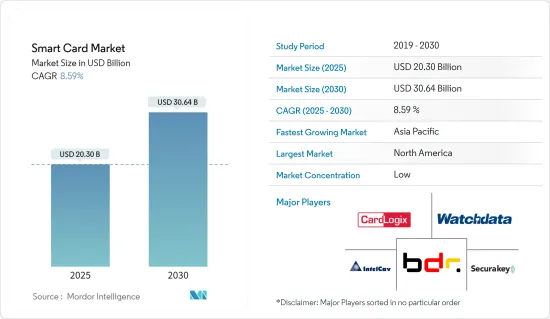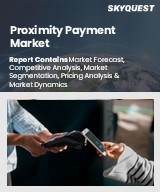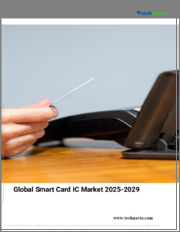
|
시장보고서
상품코드
1687766
스마트 카드 : 시장 점유율 분석, 산업 동향 및 통계, 성장 예측(2025-2030년)Smart Card - Market Share Analysis, Industry Trends & Statistics, Growth Forecasts (2025 - 2030) |
||||||
스마트 카드 시장 규모는 2025년 203억 달러에 이르고 예측기간(2025-2030년)의 CAGR은 8.59%를 나타내 2030년에는 306억 4,000만 달러에 달할 것으로 예측되고 있습니다.

디지털화의 진전, 온라인 쇼핑 수요 증가, 헬스케어 수요, 액세스 제어 용도 등이 스마트 카드 시장의 성장을 증대시키고 있는 주요 요인입니다.
주요 하이라이트
- 스마트 카드는 카드 소유자와 카드에의 액세스를 희망하는 제3자를 안전하게 식별·인증하는 방법을 제공합니다. 예를 들면, 카드 소유자는 PIN 코드나 생체 인증 데이터를 사용해 인증을 받을 수 있습니다.
- 디지털화가 진행되고 상호 연결이 진행되는 세계에서는 보안에 대한 우려가 가장 중요해지고 있습니다.
- 스마트 카드 수요는 고급 스마트 카드 보안 용도에 대한 다른 보안 및 개인 정보 보호 문제의 도입으로 인해 다양한 최종 이용 산업 시장에서의 용도에서 해마다 증가하고 있습니다. 세계적으로는 은행 및 금융업계가 스마트 카드 시장에서 큰 점유율을 차지할 것으로 예상되고 있습니다. 중요한 금융 업무가 이 업계의 핵심이기 때문에 보안은 여전히 가장 큰 초점이 되고 있습니다. 이것은 고급 인증 솔루션의 채택을 뒷받침하고 업계에서 스마트 카드의 수용을 촉진합니다.
- 액세스 제어 및 기타 용도에 사용되는 스마트 카드는 기능에 고품질의 리더와 칩을 사용하므로 비용이 많이 드는 초기 비용이 필요합니다. 리더와 칩의 배치에는 추가 비용이 필요하며, 이로써 스마트 카드 전체의 비용을 상승시켜 스마트 카드의 성장을 억제하고 있습니다.
- 유행 기간 동안 통신과 건강 관리에 특화된 스마트 카드 사업은 다른 업종에 비해 적은 영향을 받았습니다. 건강 관리 데이터의 급증은 효율적인 환자 관리 및 프라이버시를 제공하는 새로운 과제를 가져왔습니다. 스마트 카드는 안전한 스토리지(자기 스트라이프 카드에 저장할 수 있는 150바이트를 크게 초과)와 간단한 데이터 배포를 제공함으로써 이 두 가지 과제를 해결했습니다. 헬스케어 지출 증가는 헬스케어 시장에서 스마트 카드의 사용을 촉진할 것으로 예상됩니다.
- 예를 들어, Medicare & Medicaid Service Center에 따르면 미국의 의료 지출은 2027년까지 약 6조 달러에 달할 것으로 예측됩니다. 게다가 COVID-19의 발생은 여러 나라에 예방접종 예방 계획을 수립하고 있으며, 이는 또한 시장 성장을 조장할 것으로 예상됩니다. 디지털 자격 증명은 유행 관리에 큰 역할을 할 것으로 예상됩니다.
스마트 카드 시장 동향
개인 식별 및 액세스 제어 용도로의 도입 확대가 시장 성장을 견인
- 스마트 카드 시장은 주로 개인 식별 및 액세스 제어 용도에 있어서의 스마트 카드의 전개 확대에 의해 커다란 성장을 이루고 있습니다.
- 지문 스캔, 홍채 인식, 얼굴 인식 등의 생체 인증 기술의 통합으로 스마트 카드는 인증 레이어를 추가하고, 보안을 강화하고, 사용자 식별 정확성을 보장합니다.
- 개인 식별 및 액세스 제어에서 스마트 카드의 도입이 확대되고 있는 주요 요인 중 하나는 생체 인증 기술의 통합입니다. 생체인증 기능을 내장한 스마트 카드는 카드소유자의 생체인증 데이터를 신분증명서에 바인딩함으로써 보안 레이어를 추가하고 가짜가 액세스하는 것을 사실상 불가능하게 하고 있습니다.
- 또한, Biometrics Institute에 따르면 2022년 대부분의 응답자는 얼굴 인증이 향후 수년간 가장 이용이 증가하는 생체인증 기술이라고 생각한다고 답했습니다. 이 동향은 기업이나 조직이 액세스 제어나 개인 식별 시스템을 강화하기 위해 얼굴 인증 기능을 갖춘 스마트 카드를 채용하는 경향이 강해짐에 따라, 스마트 카드 시장의 성장을 견인하는 것으로 예상됩니다.
- 이러한 용도에 있어서의 스마트 카드의 편리성, 신뢰성, 확장성은 업무를 보호해, 유저의 프라이버시를 지키려고 하는 조직에 있어서 불가결한 툴이 되고 있습니다.
아시아태평양이 현저한 성장률을 보임
- 아시아태평양에서는 스마트 카드가 널리 사용되고 있기 때문에 BFSI, 건강 관리, 소매, 정부 부문 수요가 시장을 독점할 가능성이 높습니다. 또한, 데이터 보안이나 프라이버시에 관한 의식의 높아가, 기업이나 조직이 액세스 제어나 안전한 데이터 보존을 위해 스마트 카드를 채용하는 것을 뒷받침하고 있습니다.
- 중국에는 대규모 소비자 기반이 있어, 주요 스마트 카드 제조업체가 존재하기 때문에 이 지역에 있어서의 스마트 카드 수요는 왕성할 것으로 예상됩니다.스마트 카드는 많은 은행 기관에서 채용되어 시장 확대에 공헌했습니다.
- 예를 들어, China Construction Bank(CCB)는 작년에 생체인증의 하드 월렛 스마트 카드를 테스트하고 있다고 선언했으며, 이를 통해 사용자는 디지털 위안화를 저장하고 중앙은행의 디지털 통화를 사용한 지급을 확인할 수 있게 되었습니다.
- 국내에서 다양한 유형의 IC카드를 확립하기 위해 이 지역에서 영업하는 여러 은행이 IC카드 작성 회사와 제휴하고 있습니다.
- 게다가 도쿄의 일렉트로닉스 기업인 MoriX Co.는 작년 Fingerprint Cards AB와 제휴해 Fingerprints의 T-Shape 모듈을 사용한 생체 인증 결제 카드를 개발·도입했습니다.
- 시장 확대를 지원하기 위해 새로운 노력과 개발이 다른 최종 사용자에게 스마트 카드를 사용하도록 촉구하고 있습니다. 스마트 카드 이용자는 동사의 오프쇼어 개발 계획의 일환으로서, 중국 본토의 버스, 기차, 페리 등의 대중교통기관에서 지불을 할 수 있게 됩니다.
스마트 카드 산업 개요
스마트 카드 시장은 여러 세계 기업이 존재하기 때문에 단편화하고 있습니다. 주요 기업은 HID Global Corporation, CardLogix Corporation, Thales Group 등입니다.
- 2023년 7월 : IDEX Biometrics는 Goldpac Group company의 Goldpac Fintech Hong Kong Limited와 IDEX Biometrics의 완전한 지문 인증 솔루션에 기반한 생체인증 스마트 카드를 결제와 ID 액세스에 도입하기 위한 세계 협업을 발표했습니다.
- 2023년 1월 승객의 편의성을 높이기 위해 Delhi Metro는 Airtel Payments Bank와 제휴하여 스마트 카드의 탑업 기능을 추가했습니다.
기타 혜택
- 엑셀 형식 시장 예측(ME) 시트
- 3개월간의 애널리스트 서포트
목차
제1장 서론
- 조사의 전제조건과 시장 정의
- 조사 범위
제2장 조사 방법
제3장 주요 요약
제4장 시장 인사이트
- 시장 개요
- 업계의 매력도 - Porter's Five Forces 분석
- 공급기업의 협상력
- 구매자의 협상력
- 신규 참가업체의 위협
- 대체품의 위협
- 경쟁 기업간 경쟁 관계
- 업계 밸류체인 분석
- 시장에 대한 COVID-19의 영향 평가
제5장 시장 역학
- 시장 성장 촉진요인
- 개인 식별 및 액세스 제어용 배포 확대
- 여행 신원 확인 및 교통기관에서의 폭넓은 이용
- 비접촉형 결제에 대한 수요 증가
- 시장 성장 억제요인
- 프라이버시와 보안 문제, 표준화에 대한 우려
제6장 시장 세분화
- 유형별
- 접촉형
- 비접촉형
- 최종 사용자 산업별
- BFSI
- IT 및 통신
- 정부기관
- 운송
- 기타(교육, 헬스케어, 엔터테인먼트 등)
- 지역별
- 북미
- 미국
- 캐나다
- 유럽
- 영국
- 독일
- 프랑스
- 기타 유럽
- 아시아태평양
- 중국
- 일본
- 인도
- 기타 아시아태평양
- 세계 기타 지역
- 북미
제7장 경쟁 구도
- 기업 프로파일
- CardLogix Corporation
- Watchdata Technologies
- Bundesdruckerei GmbH
- IntelCav
- Secura Key
- Alioth LLC
- Gemalto NV(Thales Group)
- Giesecke & Devrient GmbH(MC Familiengesellschaft mbH)
- HID Global Corporation(Assa Abloy AB)
- IDEMIA France SAS
- Infineon Technologies AG
- Fingerprint Cards AB
- Samsung Electronics Co. Ltd
- CPI Card Group Inc.
- KONA I Co. Ltd
제8장 벤더 포지셔닝 분석
제9장 투자 분석
제10장 투자 분석 시장의 미래
KTH 25.05.09The Smart Card Market size is estimated at USD 20.30 billion in 2025, and is expected to reach USD 30.64 billion by 2030, at a CAGR of 8.59% during the forecast period (2025-2030).

The rising digitalization, increasing demand from online shopping, demand for healthcare, and access control applications are the primary factors augmenting the growth of the smart card market.
Key Highlights
- Smart cards provide methods to securely identify and authenticate the cardholder and third parties who want access to the card. For instance, a cardholder can use a PIN code or biometric data for authentication. Smart cards also provide a way to securely store data on the card and protect communications with encryption.
- In an increasingly digital and interconnected world, security concerns have become paramount. Smart cards offer robust security features, including encryption and secure storage of sensitive data, making them an ideal choice for applications that require secure authentication, such as banking, government IDs, and access control.
- The demand for smart cards has been growing each year with applications in various end-use industry markets due to the recent introduction of other security and privacy issues for advanced smart card security applications. Globally, the banking and finance industry is expected to account for a significant share of the smart card market. With critical financial operations being the industry's core, security remains the primary focus. This supports the adoption of advanced authentication solutions and promotes the acceptance of the smart card within the sector.
- The initial cost required for the smart card used for access control and other applications is high as it uses readers and chips of high quality for its functioning. The deployment of readers and chips requires additional costs, which increases the overall cost of smart cards, restraining the growth of smart cards.
- During the COVID-19 pandemic, the business for smart cards specific to telecommunications and healthcare was less affected than other verticals. The upsurge of healthcare data brings up new challenges in providing efficient patient care and privacy. Smart cards solved both challenges by providing secure storage (dramatically more than 150 bytes that can be stored on a magnetic stripe card) and easy data distribution. Increasing healthcare expenditure is anticipated to propel the use of smart cards in the healthcare market.
- For instance, according to the Centers for Medicare & Medicaid Services, US health spending is projected to reach nearly USD 6 trillion by 2027. Moreover, the emergence of COVID-19 has prompted several nations to develop vaccination-proofing plans, which are also anticipated to aid market growth. Digital credentials are expected to play a major role in managing the pandemic.
Smart Card Market Trends
Growing Deployment in Personal Identification and Access Control Applications to Drive the Market Growth
- The smart card market is experiencing significant growth, primarily driven by the expanding deployment of smart cards in personal identification and access control applications. Robust security measures have become paramount in the increasingly digital and interconnected world. Smart cards with advanced microprocessors and secure elements offer an ideal solution for verifying identities and controlling access to sensitive areas or data.
- With the integration of biometric technologies, such as fingerprint scanning, iris recognition, and facial recognition, smart cards provide an added layer of authentication, enhancing security and ensuring user identification accuracy. As a result, various industries, including government, healthcare, finance, and transportation, are increasingly adopting smart cards to secure their identification systems and access control protocols.
- One of the key drivers behind the growing deployment of smart cards in personal identification and access control is the integration of biometric technology. Biometric authentication methods, such as fingerprint scanning, iris recognition, and facial recognition, are gaining prominence due to their accuracy and uniqueness. Smart cards with embedded biometric capabilities add an extra layer of security by binding the cardholder's biometric data to their identification, making it virtually impossible for imposters to gain access.
- Moreover, according to the Biometrics Institute, in 2022, most respondents considered that face recognition was the biometric technology likely to deliver the most significant increase in usage over the next few years. By contrast, only three percent of respondents believed that fingerprint identification would significantly increase usage, as it is already the most used and developed biometric technology. This trend will likely drive the smart card market's growth as businesses and organizations increasingly adopt smart cards with face recognition capabilities to bolster access control and personal identification systems.
- The convenience, reliability, and scalability of smart cards in such applications make them essential tools for organizations seeking to safeguard their operations and protect their users' privacy. This growing deployment in personal identification and access control applications is expected to drive the smart card market's growth further in the coming years as businesses and institutions continue to prioritize security and efficiency in their operations.
Asia Pacific to Witness a Significant Growth Rate
- Since smart cards are more widely used in the Asia Pacific area, demand from the BFSI, healthcare, retail, and government sectors is likely to dominate the market. Additionally, the growth of IoT applications, smart city projects, and connected devices in the region are creating a demand for secure and scalable authentication solutions, where smart cards play a crucial role. Moreover, the growing awareness of data security and privacy concerns is encouraging enterprises and organizations to adopt smart cards for access control and secure data storage.
- A big consumer base and the presence of major smart card manufacturers in China are expected to result in a strong demand for smart cards in the region. Smart cards were adopted by a number of banking institutions, which helped the market expand.
- For instance, China Construction Bank (CCB) declared last year that they are testing a biometric 'hard wallet' smart card that enables users to store digital yuan and confirm payments made using the central bank's digital currency with their fingerprints. With the help of cutting-edge fingerprint authentication and recognition, the stored value on the card is further protected.
- To establish various types of smart cards in the nation, several banks operating in the region have partnered with smart card creators. Axis Bank, ICICI Bank, and SBM Bank are a few Indian banks that released smart cards in the latter or first quarter of the previous year.
- In addition, MoriX Co., a Tokyo-based electronics company, collaborated with Fingerprint Cards AB last year to develop and introduce biometric payment cards using the T-Shape module from Fingerprints. These cards are anticipated to be integrated with payment cards using conventional automated manufacturing techniques.
- To support market expansion, new initiatives, and developments are encouraging other end users to use smart cards. Transit cards were recently offered for users of public transportation in more than 300 Chinese cities by Octopus, one of the smart card operators in Hong Kong. Users of Octopus transit cards will be able to pay for public transportation in mainland China's buses, trains, and ferries as part of the company's offshore development plan. The maximum top-up amount for the Octopus card will initially be HKD 3,000 (USD 386), with the option to convert to digital Octopus cards in a phase two launch.
Smart Card Industry Overview
The Smart Card market is fragmented because of the presence of several global companies. Some key players are HID Global Corporation, CardLogix Corporation, Thales Group, etc. Key players in this market are introducing new innovative products and forming partnerships and collaborations to gain competitive advantages.
- July 2023- IDEX Biometrics announced a global collaboration with Goldpac Fintech Hong Kong Limited, a Goldpac Group company, to deploy biometric smart cards based on IDEX Biometrics' complete fingerprint solution for payments and identity access.
- January 2023: To enhance the convenience of passengers, the Delhi Metro has collaborated with Airtel Payments Bank, offering an additional smart card top-up facility. Customers' Internet banking details will be securely stored within the app, ensuring the utmost safety for all transactions. Taking advantage of this feature for recharging purposes will be both swift and effortless, providing a seamless experience for commuters.
Additional Benefits:
- The market estimate (ME) sheet in Excel format
- 3 months of analyst support
TABLE OF CONTENTS
1 INTRODUCTION
- 1.1 Study Assumptions and Market Definition
- 1.2 Scope of the Study
2 RESEARCH METHODOLOGY
3 EXECUTIVE SUMMARY
4 MARKET INSIGHT
- 4.1 Market Overview
- 4.2 Industry Attractiveness - Porter's Five Forces Analysis
- 4.2.1 Bargaining Power of Suppliers
- 4.2.2 Bargaining Power of Buyers
- 4.2.3 Threat of New Entrants
- 4.2.4 Threat of Substitutes
- 4.2.5 Intensity of Competitive Rivalry
- 4.3 Industry Value Chain Analysis
- 4.4 Assessment of the Impact of COVID-19 on the Market
5 MARKET DYNAMICS
- 5.1 Market Drivers
- 5.1.1 Growing Deployment in Personal Identification and Access Control Applications
- 5.1.2 Extensive Use in Travel Identity and Transportation
- 5.1.3 Growing Demand for Contactless Payments
- 5.2 Market Restraints
- 5.2.1 Privacy and Security Issues and Standardization concerns
6 MARKET SEGMENTATION
- 6.1 By Type
- 6.1.1 Contact-based
- 6.1.2 Contact-Less
- 6.2 By End-user Vertical
- 6.2.1 BFSI
- 6.2.2 IT & Telecommunication
- 6.2.3 Government
- 6.2.4 Transportation
- 6.2.5 Other End-User Industries (Education, Healthcare, Entertainment, etc.)
- 6.3 By Geography
- 6.3.1 North America
- 6.3.1.1 United States
- 6.3.1.2 Canada
- 6.3.2 Europe
- 6.3.2.1 United Kingdom
- 6.3.2.2 Germany
- 6.3.2.3 France
- 6.3.2.4 Rest of Europe
- 6.3.3 Asia Pacific
- 6.3.3.1 China
- 6.3.3.2 Japan
- 6.3.3.3 India
- 6.3.3.4 Rest of Asia Pacific
- 6.3.4 Rest of the World
- 6.3.1 North America
7 COMPETITIVE LANDSCAPE
- 7.1 Company Profiles
- 7.1.1 CardLogix Corporation
- 7.1.2 Watchdata Technologies
- 7.1.3 Bundesdruckerei GmbH
- 7.1.4 IntelCav
- 7.1.5 Secura Key
- 7.1.6 Alioth LLC
- 7.1.7 Gemalto NV (Thales Group)
- 7.1.8 Giesecke & Devrient GmbH (MC Familiengesellschaft mbH)
- 7.1.9 HID Global Corporation (Assa Abloy AB)
- 7.1.10 IDEMIA France SAS
- 7.1.11 Infineon Technologies AG
- 7.1.12 Fingerprint Cards AB
- 7.1.13 Samsung Electronics Co. Ltd
- 7.1.14 CPI Card Group Inc.
- 7.1.15 KONA I Co. Ltd



















